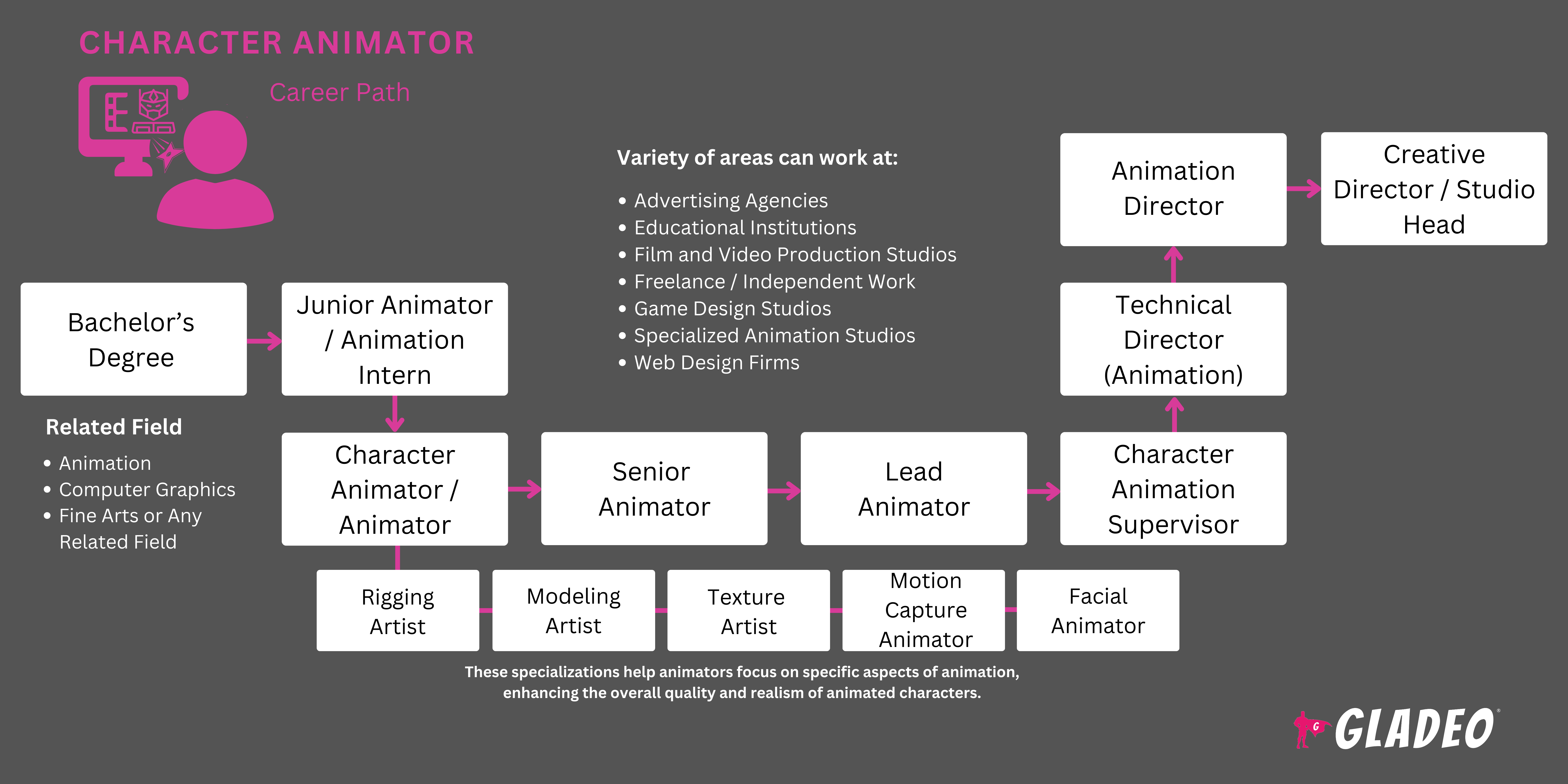Spotlights
3D Animator (Three-Dimensional Animator), 3D Artist (Three-Dimensional Artist), Animator, Artist, Digital Artist, Graphic Artist, Illustrator, Motion Graphics Artist, Multimedia Producer, 2D Animator
When you watch your favorite animated movie, play a game, or scroll through an animated ad online, every character that moves, smiles, and expresses emotion has been carefully crafted by a Character Animator. These creative professionals are responsible for bringing static drawings, digital models, or puppets to life using movement, timing, and expression. Their work is what makes characters feel believable and emotionally real.
Character Animators work closely with storyboard artists, modelers, riggers, directors, and sound designers to shape how a character moves, reacts, and performs. Using 2D or 3D animation software, they animate everything from subtle facial expressions to fast-paced action sequences. They also study real-world body language and acting techniques to give their characters personality and depth.
This career blends artistic talent, technical skill, and storytelling. Animators often spend hours refining tiny movements to make sure every frame looks right. It’s demanding work—but seeing a character you animated make people laugh, cry, or cheer is one of the most rewarding feelings in the industry.
- Watching your drawings and digital models come to life on screen.
- Collaborating with creative teams to bring unforgettable characters to movies, games, and TV shows.
- Seeing your work entertain millions of people around the world.
- Building a portfolio filled with imaginative, dynamic characters that tell powerful stories.
Working Schedule
- Character Animators usually work full-time, often in studios or remotely from home. Tight deadlines—especially near the end of a project—may mean longer hours, including evenings or weekends. Some animators work on short-term contracts, while others are employed long-term by studios, game developers, or media companies.
Typical Duties
- Create expressive, believable character movements using 2D or 3D animation tools.
- Collaborate with storyboard artists, modelers, riggers, and directors to bring characters to life.
- Adjust and refine timing, gestures, and facial expressions for natural performance.
- Use animation software to animate dialogue, action scenes, and emotional moments.
- Revise animations based on director or client feedback.
Additional Responsibilities
- Research real-world movement, body language, and acting techniques to improve character realism.
- Stay current with animation trends, tools, and technology.
- Help set the tone and personality of characters through motion and expression.
- Contribute to creative discussions and pitch ideas to improve scenes.
- Maintain organized files, naming conventions, and clean workflows for team collaboration.
Soft Skills
- Creativity and imagination
- Strong storytelling sense
- Communication and teamwork
- Patience and attention to detail
- Problem-solving
- Time management
- Adaptability and flexibility
Technical Skills
- Mastery of animation software (e.g., Autodesk Maya, Blender, Toon Boom Harmony, Adobe After Effects)
- Understanding of body mechanics, acting, and timing
- Rigging and character movement principles
- Knowledge of lighting, rendering, and camera work
- Motion capture familiarity (for some productions)
- Clean file management and pipeline integration
- Animation and film studios
- Video game development companies
- Television and streaming platforms
- Advertising agencies
- Educational media and e-learning companies
- Freelance or contract-based creative projects
A typical day for a Character Animator often begins with a team check-in, where animators review storyboards, project updates, and deadlines. The bulk of the day is spent in animation software, bringing characters to life through movement, emotion, and timing. Some animators record themselves acting out scenes for reference to make performances more believable.
Midday might involve feedback sessions with the director or lead animator, adjusting scenes to better match the creative vision. Near deadlines, the pace can be fast, with multiple revisions and refinements. Watching a finished sequence come alive on screen is one of the most satisfying parts of the job.
- 2D Animators: Specialize in hand-drawn or digital frame-by-frame animation.
- 3D Animators: Use digital models and rigs to create movement in 3D environments.
- Game Animators: Focus on interactive animation for video games.
- Motion Capture Animators: Work with performance data from actors to refine character movement.
- VFX Animators: Add realistic or stylized character motion to live-action footage.
Animation is exciting but demanding. Deadlines can be intense, and animators often spend long hours perfecting small details. Revision cycles are frequent, and feedback can be extensive. Many start in junior roles, working their way up through practice and experience.
But the rewards are worth it—seeing your character on the big screen or in a game played by thousands of people is incredibly fulfilling. As one animator put it, “You breathe life into something that didn’t exist before—and that never gets old.”
Animation is rapidly evolving with new technology. Real-time rendering tools and AI-assisted animation are speeding up workflows. Stylized animation, hybrid 2D/3D techniques, and virtual production are growing trends. There’s also rising demand for animators in streaming, indie games, and educational content—not just big-budget films.
Many animators loved drawing, doodling, acting, or storytelling as kids. They often spent hours sketching characters, reading comics, or watching animated films closely to understand how movement works. Some liked playing video games and imagining how they’d design their own characters and scenes.
- ~70% of Character Animators hold a bachelor’s degree in animation, fine arts, computer graphics, or a related field. Some begin as interns or junior artists and build their way up through practice, workshops, and on-the-job experience. Others sharpen their skills through online courses, art programs, or specialized animation boot camps.
- Common undergraduate courses include:
- Drawing and figure studies
- 2D and 3D animation techniques
- Digital illustration
- Computer graphics and modeling
- Motion capture and rigging
- Storyboarding and visual storytelling
- Character design
- Film and media studies
- Optional certifications include:
- Adobe – Certified Professional (for software like Adobe After Effects and Adobe Animate)
- Autodesk – Certified Professional (for Autodesk Maya and Autodesk 3ds Max)
- Toon Boom Animation Inc. – Certified Toon Boom Artist
- The Animation Guild – professional membership and training programs
- Many Character Animators also develop strong portfolios or demo reels to showcase their skills to employers. Because this field is highly visual and skill-based, hands-on experience often matters just as much as formal education. Animators may work in film, TV, gaming, advertising, or web media, and mastering multiple animation software tools can make candidates more competitive.
- Take art, graphic design, drama, or computer science classes.
- Join or start an animation or film club.
- Enter drawing, animation, or short film contests.
- Practice creating short animated clips for fun or school projects.
- Build a portfolio to showcase your best work.
- Experiment with different animation software and tools early on.
- Collaborate with classmates on creative projects like short films or game design.
- Watch behind-the-scenes animation documentaries to understand industry workflows.
- Attend workshops, conventions, or local film festivals to meet professionals.
- Volunteer or intern with school media departments, theater productions, or community art programs.
- Hands-on animation training with industry-standard software.
- Access to internships or real-world studio projects.
- Faculty or mentors with professional animation experience.
- Strong portfolio development support.
- Opportunities to collaborate on team-based productions.
- Courses that cover both 2D and 3D animation techniques.
- Up-to-date facilities with high-performance computers and animation labs.
- Career services or job placement assistance for graduates.
- Programs that encourage creative storytelling and character development.
- Networking opportunities with industry professionals and alumni.
- Access to workshops, masterclasses, and guest lectures from working animators.
- Flexible elective options to explore related fields like game design, film production, or visual effects.

- Build a strong demo reel showcasing your best animation work.
- Search for internships or entry-level roles like animation assistant or junior animator.
- Look for openings at studios, game developers, or freelance platforms.
- Network at animation festivals, online communities, or through alumni connections.
- Customize your resume and portfolio for each role.
- Be open to contract or freelance work to build experience.
- Keep your online portfolio and professional profiles updated.
- Join professional associations or animation guilds to access job boards and resources.
- Learn how to talk about your creative process during interviews.
- Be persistent and open to feedback—many animators start small before landing big projects.
- Follow animation studios and production companies on social media to catch early job postings.
- Consider collaborating on indie projects to gain real-world experience.
- Master advanced animation techniques and specialize in an area like character performance, rigging, or cinematics.
- Continuously update your skills with the latest tools and trends.
- Build a reputation for creativity, reliability, and teamwork.
- Take on leadership roles like Lead Animator or Animation Supervisor.
- Network with directors, producers, and other creative leads.
- Showcase your work through film festivals, online platforms, and professional networks.
- Mentor junior animators and contribute to creative direction.
- Consider joining professional organizations or animation guilds for more opportunities.
- Learn project management or directing skills to move into senior creative roles.
- Develop a signature style or niche that sets you apart in the industry.
Websites
- Animation Mentor
- ArtStation
- CreativeBloq
- CGSociety
- Behance
- LinkedIn (for job listings and networking)
- Indeed (for entry-level and freelance animation jobs)
- Glassdoor (to research companies and roles)
- The Animation Guild (for industry news and job resources)
- Upwork and Fiverr (for freelance opportunities)
- Dribbble (for showcasing creative work and connecting with studios)
- Monster (for broader job searches in creative industries)
- Mandy (for film, TV, and animation gigs)
- EntertainmentCareers.net (for internships and industry jobs)
Books
- The Animator’s Survival Kit by Richard Williams
- Acting for Animators by Ed Hooks
- Timing for Animation by Harold Whitaker and John Halas
As you can see, working as a Character Animator can be an exciting and creative career, but it’s not the only path in the animation and media industry. If this job sounds interesting but you’d like to explore other options, consider these related careers:
- 2D/3D Animator
- Motion Graphics Designer
- Concept Artist
- Storyboard Artist
- Game Designer
- Visual Effects (VFX) Artist
- Multimedia Artist
- Illustrator
- Graphic Designer
- Animation Technical Director (TD)
- Art Director
Newsfeed

Featured Jobs

Online Courses and Tools

Annual Salary Expectations
New workers start around $98K. Median pay is $135K per year. Highly experienced workers can earn around $171K.






